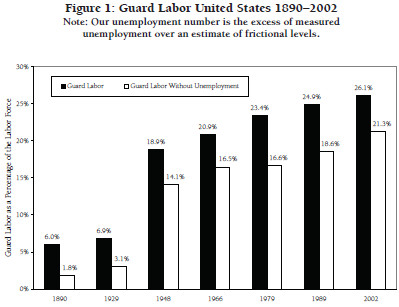One fourth of the American work force is employed in “guard labor”, not producing anything themselves, but keeping the actual workers in line, according to a studies by economists Samuel Bowles of the Santa Fe Institute and Arjun Jayadev of the University of Massachusetts.
Comparing nations, they reported that the greater the amount of inequality in a society, the higher the percentage employed in guard labor.
The following is from an interview with Samuel Bowles in the Santa Fe Reporter.
Inequality leads to an excess of what Bowles calls “guard labor.” In a 2007 paper on the subject, he and co-author Arjun Jayadev, an assistant professor at the University of Massachusetts, make an astonishing claim: Roughly 1 in 4 Americans is employed to keep fellow citizens in line and protect private wealth from would-be Robin Hoods.
The job descriptions of guard labor range from “imposing work discipline”—think of the corporate IT spies who keep desk jockeys from slacking off online—to enforcing laws, like the officers in the Santa Fe Police Department paddy wagon parked outside of Walmart.
The greater the inequalities in a society, the more guard labor it requires, Bowles finds. This holds true among US states, with relatively unequal states like New Mexico employing a greater share of guard labor than relatively egalitarian states like Wisconsin.
The problem, Bowles argues, is that too much guard labor sustains “illegitimate inequalities,” creating a drag on the economy. All of the people in guard labor jobs could be doing something more productive with their time—perhaps starting their own businesses or helping to reduce the US trade deficit with China.
The category of “guard labor” includes police, prison guards, court workers, military and civilian employees of the Department of Defense and private guards, as well as monitors and supervisors with the power to reward and punish. They do not count employees of companies that make burglar alarms, video surveillance cameras and other security equipment.
They do count the unemployed and prisoners, which may seem like a stretch. Bowles and Jayadev argue that if nobody was out of work and nobody was in jail, there wouldn’t be any way to keep the rest of the population in line. This is in line with Karl Marx’s idea that employers need a “reserve army” of the unemployed to keep wages low.
But even excluding the unemployed, Bowles and Jayadev said that “guard labor” is about a fifth of the American work force.
The chart below shows the growth of guard labor in the United States. By their count, the percentage of U.S. workers in guard labor nearly quadrupled in the 20th century, and increased more than 10 times if you don’t count the unemployed.
This is old information, but I don’t think the trend has reversed. I see armed security guards and video monitors everywhere I go and, while I’m retired, my friends tell me that work conditions are getting more and more restrictive.
In the best of societies, there will be a need for a certain number of supervisors, monitors, police, courts, prison guards and military forces, and there will be a certain number of prison inmates and job-seekers. But Bowles and Jayadev found that the percentage is much greater in nations with a high degree of economic inequality, such as the USA, which has more than double the percentage of guard labor of Sweden or Denmark. Where there are no extremes of rich and poor, it is not necessary to devote so much effort to keeping people in line.
Click on Guard Labor PDF to read the 2006 paper by Samuel Bowels and Arjun Jayadev.
Click on Garrison America PDF to read the 2007 paper by Samuel Bowles and Arjun Jayadev.
Click on Crime and Punishment: Some Costs of Inequality for a report by Nancy Folbre in the New York Times.
Click on Born Poor? Santa Fe Economist Samuel Bowles Says You’d Better Get Used to It for the full interview in the Santa Fe Reporter.
Click on Vested interests in mass incarceration for an earlier post of mine on a related subject.
Hat tip to Nina Paley for the Mimi and Eunice cartoon.
[Added Later] Click on One Nation Under Guard for a New York Times article by Samuel Bowles and Arjun Jayadev.
Tags: Arjun Jayadev, Economic inequality, Garrison America, Guard Labor, Red and Black, Samuel Bowles


April 24, 2013 at 9:12 am |
Reblogged this on The Deliberate Observer.
LikeLike
April 26, 2013 at 4:11 pm |
[…] via One in four US workers are “guard labor” | Phil Ebersole’s Blog. […]
LikeLike
November 12, 2013 at 11:07 pm |
[…] doesn’t seem to understand the implications of one type of work that would grow in his future: guard labor. Guard labor refers to the police officers, security guards, and corrections officers that keep […]
LikeLike
February 24, 2015 at 10:14 am |
Reblogged this on Citizens, not serfs.
LikeLike